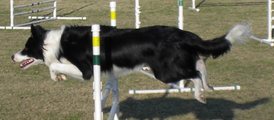What is Agility?
Agility began as an exhibition sport in Great Britain and was imported to the United States in 1977. The sport was patterned after equestrian events and combines handler control, agility, and confidence. The sport of agility is comprised of a course set up of many different obstacles. Agility is meant to be a fun, non-regimented sport, with a lot of spectator appeal. Obstacles include jumps, tunnels, a dog walk, a see-saw or teeter, an A-frame and weave poles.
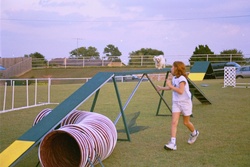 The Dogwalk requires the dog to walk up, over and down in the
direction designated by the judge. The dog should touch the safety
contact zones both on the ascent and the descent (mount and dismount).
Faults are assessed for missing the safety contact zones.
The Dogwalk requires the dog to walk up, over and down in the
direction designated by the judge. The dog should touch the safety
contact zones both on the ascent and the descent (mount and dismount).
Faults are assessed for missing the safety contact zones.
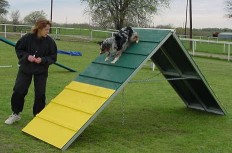 On the A-Frame, the dog is required to walk up, over and down
in the direction designated by the judge, touching the safety contact
zones both on the ascent and the descent. Some venues (AKC for
example) do not require the dog to touch the up contact, but requires
the dog to touch the down contact zone. Faults are assessed for
missing the safety contact zones.
On the A-Frame, the dog is required to walk up, over and down
in the direction designated by the judge, touching the safety contact
zones both on the ascent and the descent. Some venues (AKC for
example) do not require the dog to touch the up contact, but requires
the dog to touch the down contact zone. Faults are assessed for
missing the safety contact zones.
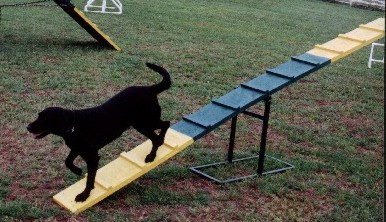 The Teeter is a dogwalk requires the dog to walk up, over and
down. The dog should touch the safety contact zones both on the
ascent and the descent. Faults are assessed for missing the safety
contact zones, and for leaving the plank before it completely settles
on the ground (typically called a fly-off).
The Teeter is a dogwalk requires the dog to walk up, over and
down. The dog should touch the safety contact zones both on the
ascent and the descent. Faults are assessed for missing the safety
contact zones, and for leaving the plank before it completely settles
on the ground (typically called a fly-off).
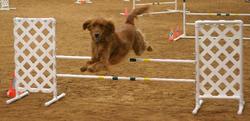 The performance of the Jumps (single, double, and triple) is
simple. The dog must go between the standards, and over the bars in
the direction designated by the judge. Knocking the bars will be
faulted.
The performance of the Jumps (single, double, and triple) is
simple. The dog must go between the standards, and over the bars in
the direction designated by the judge. Knocking the bars will be
faulted.
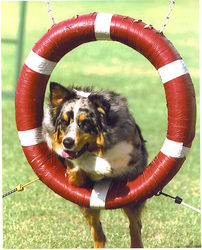 The Tire is a hoop suspended in the air. The required
performance is for the dog to jump through the hoop in the direction
designated by the judge.
The Tire is a hoop suspended in the air. The required
performance is for the dog to jump through the hoop in the direction
designated by the judge.
 For the Tunnel, the dog's job is to get in and go through in
the direction designated by the judge.
For the Tunnel, the dog's job is to get in and go through in
the direction designated by the judge.
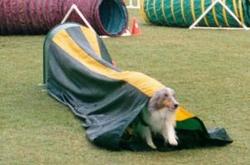 With the Collapsed Tunnel (Chute), the dog's job is to get in,
and go through in the direction designated by the judge, pushing
through the fabric chute.
With the Collapsed Tunnel (Chute), the dog's job is to get in,
and go through in the direction designated by the judge, pushing
through the fabric chute.
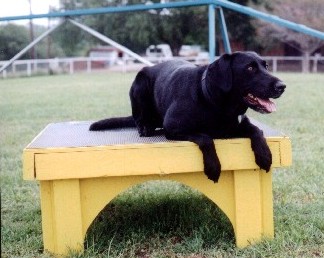 The dog must get up on the Table and assume a control position
while the judge counts five seconds. In the USDAA the control
position is always a down. In AKC, the control position might
be either a sit or a down. Faults are assessed for
thedog leaving the table before finishing the performance during the
judge's count.
The dog must get up on the Table and assume a control position
while the judge counts five seconds. In the USDAA the control
position is always a down. In AKC, the control position might
be either a sit or a down. Faults are assessed for
thedog leaving the table before finishing the performance during the
judge's count.
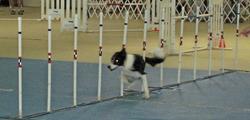 For the Weave Poles, the dog is required to enter the line of
poles from right to left in the direction designated by the judge, and
weave alternately down the line. All odd-numbered poles will be
performed on the dog's left, and all even-numbered poles will on the
dog's right. Faults are typically assessed for going past a pole on
the wrong side.
For the Weave Poles, the dog is required to enter the line of
poles from right to left in the direction designated by the judge, and
weave alternately down the line. All odd-numbered poles will be
performed on the dog's left, and all even-numbered poles will on the
dog's right. Faults are typically assessed for going past a pole on
the wrong side.

